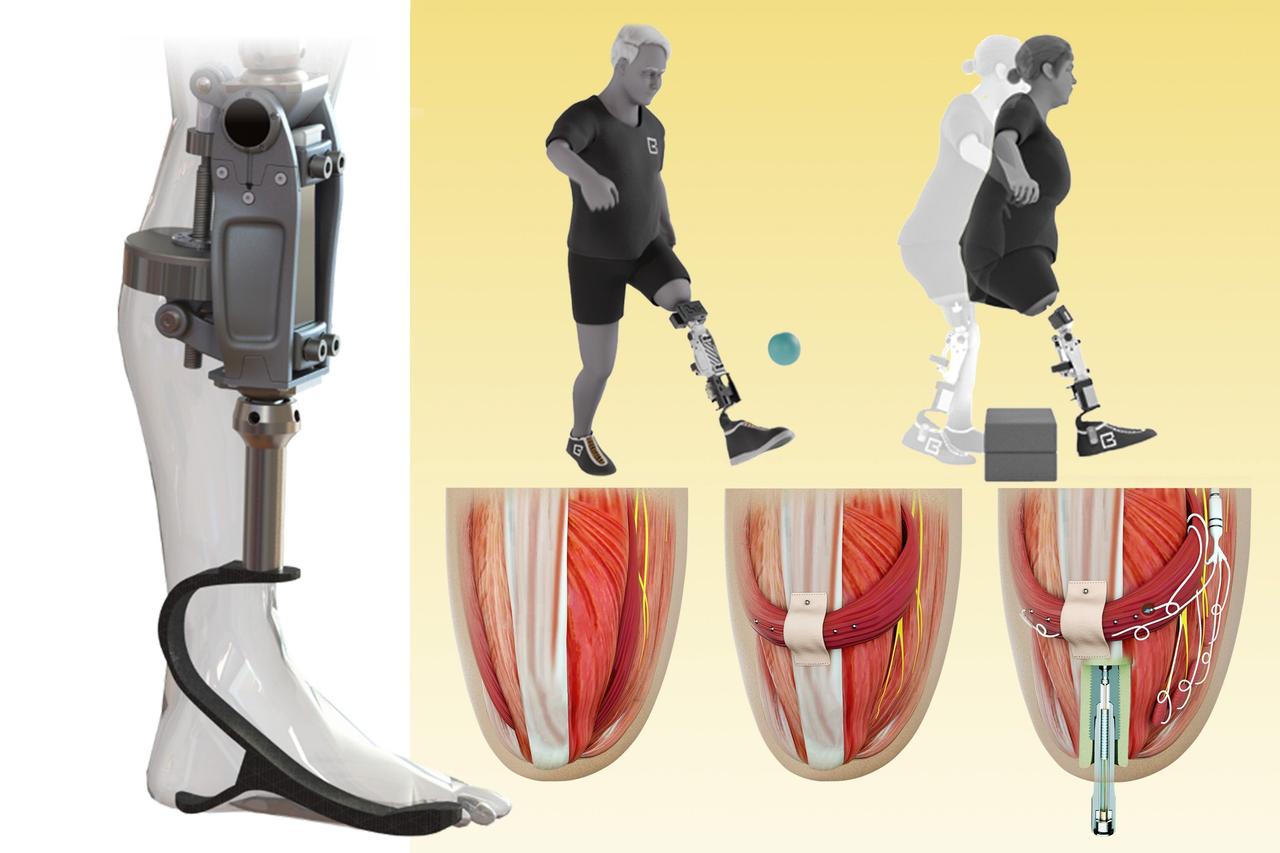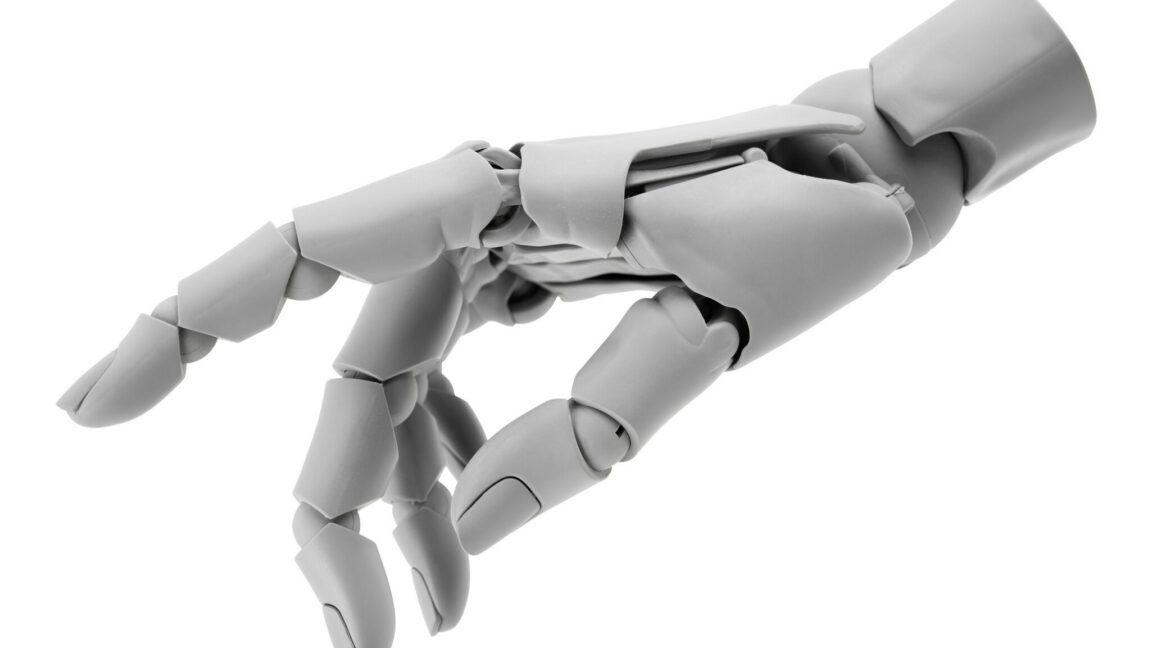MIT's Bionic Knee Breakthrough: Integrating Prosthetics with Human Physiology
4 Sources
4 Sources
[1]
A bionic knee integrated into tissue can restore natural movement
Caption: A subject with the osseointegrated mechanoneural prosthesis overcomes an obstacle placed in their walking path by volitionally flexing and extending their phantom knee joint. Control signals from their residual knee muscles are used to produce movement of the powered prosthetic knee that mirrors the phantom knee. MIT researchers have developed a new bionic knee that can help people with above-the-knee amputations walk faster, climb stairs, and avoid obstacles more easily than they could with a traditional prosthesis. Unlike prostheses in which the residual limb sits within a socket, the new system is directly integrated with the user's muscle and bone tissue. This enables greater stability and gives the user much more control over the movement of the prosthesis. Participants in a small clinical study also reported that the limb felt more like a part of their own body, compared to people who had more traditional above-the-knee amputations. "A prosthesis that's tissue-integrated -- anchored to the bone and directly controlled by the nervous system -- is not merely a lifeless, separate device, but rather a system that is carefully integrated into human physiology, offering a greater level of prosthetic embodiment. It's not simply a tool that the human employs, but rather an integral part of self," says Hugh Herr, a professor of media arts and sciences, co-director of the K. Lisa Yang Center for Bionics at MIT, an associate member of MIT's McGovern Institute for Brain Research, and the senior author of the new study. Tony Shu PhD '24 is the lead author of the paper, which appears today in Science. Better control Over the past several years, Herr's lab has been working on new prostheses that can extract neural information from muscles left behind after an amputation and use that information to help guide a prosthetic limb. During a traditional amputation, pairs of muscles that take turns stretching and contracting are usually severed, disrupting the normal agonist-antagonist relationship of the muscles. This disruption makes it very difficult for the nervous system to sense the position of a muscle and how fast it's contracting. Using the new surgical approach developed by Herr and his colleagues, known as agonist-antagonist myoneuronal interface (AMI), muscle pairs are reconnected during surgery so that they still dynamically communicate with each other within the residual limb. This sensory feedback helps the wearer of the prosthesis to decide how to move the limb, and also generates electrical signals that can be used to control the prosthetic limb. In a 2024 study, the researchers showed that people with amputations below the knee who received the AMI surgery were able to walk faster and navigate around obstacles much more naturally than people with traditional below-the-knee amputations. In the new study, the researchers extended the approach to better serve people with amputations above the knee. They wanted to create a system that could not only read out signals from the muscles using AMI but also be integrated into the bone, offering more stability and better sensory feedback. To achieve that, the researchers developed a procedure to insert a titanium rod into the residual femur bone at the amputation site. This implant allows for better mechanical control and load bearing than a traditional prosthesis. Additionally, the implant contains 16 wires that collect information from electrodes located on the AMI muscles inside the body, which enables more accurate transduction of the signals coming from the muscles. This bone-integrated system, known as e-OPRA, transmits AMI signals to a new robotic controller developed specifically for this study. The controller uses this information to calculate the torque necessary to move the prosthesis the way that the user wants it to move. "All parts work together to better get information into and out of the body and better interface mechanically with the device," Shu says. "We're directly loading the skeleton, which is the part of the body that's supposed to be loaded, as opposed to using sockets, which is uncomfortable and can lead to frequent skin infections." In this study, two subjects received the combined AMI and e-OPRA system, known as an osseointegrated mechanoneural prosthesis (OMP). These users were compared with eight who had the AMI surgery but not the e-OPRA implant, and seven users who had neither AMI nor e-OPRA. All subjects took a turn at using an experimental powered knee prosthesis developed by the lab. The researchers measured the participants' ability to perform several types of tasks, including bending the knee to a specified angle, climbing stairs, and stepping over obstacles. In most of these tasks, users with the OMP system performed better than the subjects who had the AMI surgery but not the e-OPRA implant, and much better than users of traditional prostheses. "This paper represents the fulfillment of a vision that the scientific community has had for a long time -- the implementation and demonstration of a fully physiologically integrated, volitionally controlled robotic leg," says Michael Goldfarb, a professor of mechanical engineering and director of the Center for Intelligent Mechatronics at Vanderbilt University, who was not involved in the research. "This is really difficult work, and the authors deserve tremendous credit for their efforts in realizing such a challenging goal." A sense of embodiment In addition to testing gait and other movements, the researchers also asked questions designed to evaluate participants' sense of embodiment -- that is, to what extent their prosthetic limb felt like a part of their own body. Questions included whether the patients felt as if they had two legs, if they felt as if the prosthesis was part of their body, and if they felt in control of the prosthesis. Each question was designed to evaluate the participants' feelings of agency, ownership of device, and body representation. The researchers found that as the study went on, the two participants with the OMP showed much greater increases in their feelings of agency and ownership than the other subjects. "Another reason this paper is significant is that it looks into these embodiment questions and it shows large improvements in that sensation of embodiment," Herr says. "No matter how sophisticated you make the AI systems of a robotic prosthesis, it's still going to feel like a tool to the user, like an external device. But with this tissue-integrated approach, when you ask the human user what is their body, the more it's integrated, the more they're going to say the prosthesis is actually part of self." The AMI procedure is now done routinely on patients with below-the-knee amputations at Brigham and Women's Hospital, and Herr expects it will soon become the standard for above-the-knee amputations as well. The combined OMP system will need larger clinical trials to receive FDA approval for commercial use, which Herr expects may take about five years. The research was funded by the Yang Tan Collective and DARPA.
[2]
New bionic knee connects directly with muscles and bone to feel more like the user's body
A study participant with the bone-integrated prosthesis dodges obstacles in their path (Image credit: MIT) A newly developed bionic knee could help people with above-the-knee amputations walk and climb with greater ease than they could with a traditional prosthesis. The new prosthesis, described July 10 in the journal Science, connects to a user's leg via a titanium rod attached to their femur and permanently implanted electrodes in their leg muscles. In addition to improving movement capabilities, the prosthesis helped users feel a greater sense of ownership and agency over the prosthetic limb, the researchers said. "A prosthesis that's tissue-integrated -- anchored to the bone and directly controlled by the nervous system -- is not merely a lifeless, separate device, but rather a system that is carefully integrated into human physiology, offering a greater level of prosthetic embodiment," study co-author Hugh Herr, a professor of media arts and sciences at MIT who develops prostheses that emulate natural limbs and is himself a double amputee, said in a statement. "It's not simply a tool that the human employs, but rather an integral part of self." Whereas conventional prosthetic legs attach to the user's residual limb with a socket, the new bionic prosthesis interfaces directly with muscle and bones. Doing so allows it to take advantage of a surgical approach to amputations recently developed by Herr and colleagues. In this new approach, surgeons reconnect pairs of muscles that stretch and contract in opposition to each other, such as the residual hamstring and quadriceps muscles, so that they can still communicate with each other. In conventional above-the-knee amputations, these muscles are not reconnected, which can make it more difficult to control a prosthesis. The new study also introduced a technique to integrate the system into the residual femur at the amputation site. This technique allows for better stability and load bearing than a traditional prosthesis. "All parts work together to better get information into and out of the body and better interface mechanically with the device," study co-author Tony Shu, a biomechatronics researcher who performed the research while a graduate student at MIT, said in the statement. "We're directly loading the skeleton, which is the part of the body that's supposed to be loaded, as opposed to using sockets, which is uncomfortable and can lead to frequent skin infections." In the new study, two people who had previously received traditional above-the-knee amputations underwent surgery to receive both the muscle-connecting procedure and the bone-integrated implant. The study compared these people with seven others who'd had the muscle surgery but not the bone implant and with eight people who'd had neither. All of the study participants used the same powered knee prosthesis, albeit connected in different ways, for tasks including climbing stairs, stepping over obstacles, and bending and straightening the bionic knee. The people who received the combined system performed better in almost all of the tasks than those who received only the muscle-connecting surgery, the team found. They also performed much better than the people who used traditional prostheses. The two participants who received both the muscle surgery and the implant also showed greater increases in their sense of ownership, or the feeling that the prosthetic limb was part of their body, and agency, or the ability to intentionally control the device, after completing the tasks in the study. "No matter how sophisticated you make the AI systems of a robotic prosthesis, it's still going to feel like a tool to the user, like an external device," Herr said. "But with this tissue-integrated approach, when you ask the human user what is their body, the more it's integrated, the more they're going to say the prosthesis is actually part of self." The prosthesis is not yet commercially available. Clinical trials for Food and Drug Administration approval could take about five years, Herr said in the statement.
[3]
MIT's integrated bionic knee enables natural movement in amputees
The new bionic knee is directly integrated with the user's muscle and bone tissue (bottom row right), allowing for faster and more fluid motion than with a traditional prosthesis Researchers at the Massachusetts Institute of Technology (MIT) have developed a method to restore astoundingly natural movement in people who have had leg amputations above the knee. Rather than fit an artificial limb into a socket, the team has created a bionic knee that can be integrated with a patient's muscle and bone - enabling them to move much more easily than with previous prostheses. The new bone-integrated system, dubbed e-OPRA (enhanced Osseointegrated Prostheses for the Rehabilitation of Amputees), is said to not only help patients walk faster, climb stairs, and avoid obstacles with ease, but also provide greater stability and control over movements. In the video below, you can see a patient - with just a few inches of upper thigh and femur connected to the new prosthetic limb - demonstrating motion that's surprisingly fluid as they walk and kick a ball. The tech comes from a team including Media Arts & Sciences professor Hugh Herr, who's been running a biomechatronics lab at MIT for years. Herr developed a deep passion for mountain climbing in his early teens, lost the lower halves of both legs to frostbite after being caught in a blizzard, resumed climbing, and subsequently led pioneering research in prosthetics. A brief profile of Herr is provided in the clip below. This breakthrough follows work presented by Herr and his team from last year, where they showed how nervous-system-driven prostheses for below-the-knee amputees gave them greater control over their movements. Indeed, both projects follow a surgical technique that Herr's lab has been exploring for years called agonist-antagonist myoneuronal interface (AMI), which involves reconnecting muscle pairs so they can communicate their position and the speed of their contraction with each other within the residual limb. That sensory feedback helps the patient decide how to move their prosthetic limb, and accurately control it. The above-the-knee system features a titanium rod implanted into the residual femur bone, along with wires that gather information from electrodes located on the AMI muscles within the body. The idea behind this approach is to provide better load-bearing and mechanical control of the prosthesis than a socket-based option, while avoiding the possibility of skin infections. Signals from the AMI muscles are transmitted to a custom-built robotic controller, which calculates the torque necessary to move the bionic knee just the way the user intends. Two study participants who had received the combined AMI and e-OPRA system performed better at numerous physical tasks involving the prosthetics than others who had the AMI surgery but not the e-OPRA implant, and a third group who had neither AMI nor e-OPRA. Additionally, the researchers found that the two participants who received the combined bionic knee system showed significantly greater feelings of agency and ownership of the prosthesis as part of their body. The study's findings were published in the journal Science last week. "No matter how sophisticated you make the AI systems of a robotic prosthesis, it's still going to feel like a tool to the user, like an external device," says Herr. "But with this tissue-integrated approach, when you ask the human user what is their body, the more it's integrated, the more they're going to say the prosthesis is actually part of self." Hopefully, this work will make advanced prosthetics for above-the-knee amputees more easily accessible in the near future. Herr expects that could take about five years, during which time the combined AMI and e-OPRA systems will go through larger clinical trials for Food and Drug Administration (FDA) approval in the US. The team's work follows some fascinating recent innovations in more natural artificial limbs. Last year, researchers in Italy created an intricate unpowered prosthetic foot with a structure designed to closely replicate the bones in a real foot. And earlier this year, biomedical engineers at Johns Hopkins University presented a prosthetic hand that can grip a range of objects with just the right amount of pressure needed to hold them securely without damaging them.
[4]
Bionic Knee Allows Better Movement For Amputees
By Dennis Thompson HealthDay ReporterFRIDAY, July 11, 2025 (HealthDay News) -- "Better. Stronger. Faster." Those words were written for TV's bionic "Six Million Dollar Man," but they could soon apply to everyday folks with above-the-knee amputations, a new study says. A new bionic knee allows amputees to walk faster, climb stairs more easily, and adroitly avoid obstacles, researchers reported July 10 in the journal Science. The new prothesis is directly integrated with the person's muscle and bone tissue, enabling greater stability and providing more control over its movement, researchers said. Two people equipped with the prosthetic said the limb felt more like a part of their own body, the study says. "A prosthesis that's tissue-integrated -- anchored to the bone and directly controlled by the nervous system -- is not merely a lifeless, separate device, but rather a system that is carefully integrated into human physiology, offering a greater level of prosthetic embodiment," senior researcher Hugh Herr, co-director of the K. Lisa Yang Center for Bionics at MIT, said in a news release. Artificial legs created for typical amputations have a socket into which the amputee's residual leg slips, researchers said. But the bionic knee extends into the residual leg itself, integrating the muscle and bone of the limb into the prosthetic. "It's not simply a tool that the human employs, but rather an integral part of self," Hugh said. For the bionic prosthetic, doctors insert a titanium rod into the remaining femur bone at the amputation site, which allows for better mechanical control and load bearing than a traditional artificial leg. "We're directly loading the skeleton, which is the part of the body that's supposed to be loaded, as opposed to using sockets, which is uncomfortable and can lead to frequent skin infections," lead researcher Tony Shu, an MIT graduate student, said in a news release. The implant also contains wires and electrodes that collect information from muscles remaining in the person's residual leg. Data collected by the implant goes to a new robotic controller, which uses the information to calculate the torque necessary to move the prothesis as intended by the user, researchers said. "All parts work together to better get information into and out of the body and better interface mechanically with the device," Shu said. Two people got the bionic prosthesis, which researchers call the osseointegrated mechanoneural prosthesis (OMP). They, along with 15 other amputees, took a turn at using an experimental powered knee prosthesis developed by MIT. The man and woman with the OMP wound up with significantly improved performance compared to those with traditional amputations, researchers said. They were better at walking, bending the knee to a specified angle, climbing stairs and stepping over obstacles, results showed. Those with the OMP also felt more like the artificial leg was a part of them, researchers added. "No matter how sophisticated you make the AI systems of a robotic prosthesis, it's still going to feel like a tool to the user, like an external device," Herr said. "But with this tissue-integrated approach, when you ask the human user what is their body, the more it's integrated, the more they're going to say the prosthesis is actually part of self." Larger clinical trials will be needed for the OMP system to receive U.S. Food and Drug Administration approval, which could take about five years, Herr said.
Share
Share
Copy Link
MIT researchers have developed a revolutionary bionic knee that integrates directly with muscle and bone tissue, offering improved mobility and a greater sense of embodiment for above-knee amputees.
Revolutionary Bionic Knee Design
Researchers at the Massachusetts Institute of Technology (MIT) have developed a groundbreaking bionic knee that promises to significantly improve the lives of above-knee amputees. This innovative prosthesis, described in a recent study published in the journal Science, integrates directly with the user's muscle and bone tissue, offering superior mobility and a greater sense of embodiment compared to traditional prosthetic limbs
1
2
3
.
Source: MIT
Advanced Integration Techniques
The new bionic knee employs two key technologies:
-
Agonist-Antagonist Myoneuronal Interface (AMI): This surgical approach reconnects pairs of muscles that work in opposition, such as the hamstring and quadriceps, allowing them to communicate within the residual limb. This restoration of the natural muscle dynamics provides crucial sensory feedback, enabling more intuitive control of the prosthesis
1
3
. -
Enhanced Osseointegrated Prostheses for the Rehabilitation of Amputees (e-OPRA): This bone-integrated system involves implanting a titanium rod into the residual femur bone. The implant contains 16 wires that collect information from electrodes placed on the AMI muscles, facilitating more accurate signal transduction
1
2
.
Improved Functionality and Control
The combination of AMI and e-OPRA, termed the osseointegrated mechanoneural prosthesis (OMP), offers several advantages over traditional socket-based prostheses:
- Better stability and load-bearing capacity
- Enhanced mechanical control
- Reduced risk of skin infections associated with socket prostheses
- Improved sensory feedback for more natural movement
1
2
3
4
Clinical Study Results

Source: New Atlas
A small clinical study compared the performance of two subjects with the OMP system against those with only AMI surgery and those with neither AMI nor e-OPRA. The results were promising:
- OMP users demonstrated superior performance in tasks such as walking, bending the knee to specific angles, climbing stairs, and navigating obstacles
1
2
3
. - Participants reported a greater sense of ownership and agency over the prosthetic limb, indicating improved integration with their body image
2
3
.
Related Stories
Future Prospects and Challenges
While the results are encouraging, the bionic knee is not yet commercially available. Professor Hugh Herr, a senior author of the study and co-director of the K. Lisa Yang Center for Bionics at MIT, estimates that it may take about five years for the system to receive FDA approval through larger clinical trials
2
3
4
.Broader Impact on Prosthetic Technology
This development is part of a broader trend in creating more natural and intuitive prosthetic limbs. Recent innovations in the field include:
- An intricate unpowered prosthetic foot designed to replicate the bone structure of a real foot
- A prosthetic hand capable of gripping objects with appropriate pressure
3
As research in this area continues to advance, the line between artificial limbs and natural body parts may become increasingly blurred, offering hope for improved quality of life for amputees worldwide.
References
Summarized by
Navi
[2]
[4]
Related Stories
Revolutionary Algorithm Transforms Robotic Prosthetics to Restore Natural Movement and Prevent Secondary Health Issues
20 Nov 2025•Health

AI Co-Pilot for Bionic Hands Transforms How Amputees Control Prosthetics with Intuitive Grasping
09 Dec 2025•Health

Revolutionary AI-Powered Material Allows Amputees to Adjust Prosthetic Fit via Smartphone
27 Mar 2025•Health

Recent Highlights
1
Google launches Gemini 3 Flash as default AI model, delivering speed with Pro-grade reasoning
Technology

2
OpenAI launches GPT Image 1.5 as AI image generator war with Google intensifies
Technology

3
OpenAI launches ChatGPT app store, opening doors for third-party developers to build AI-powered apps
Technology





